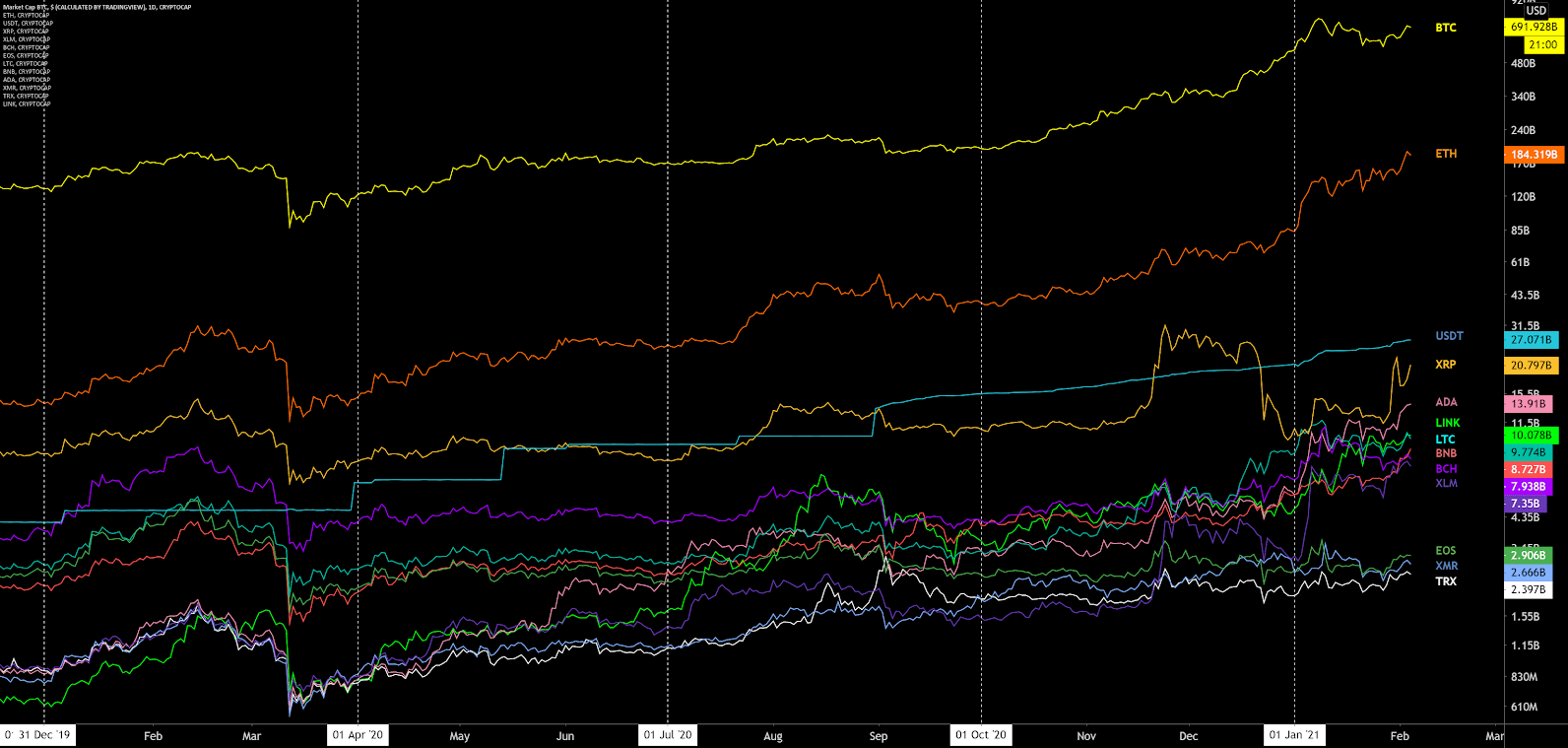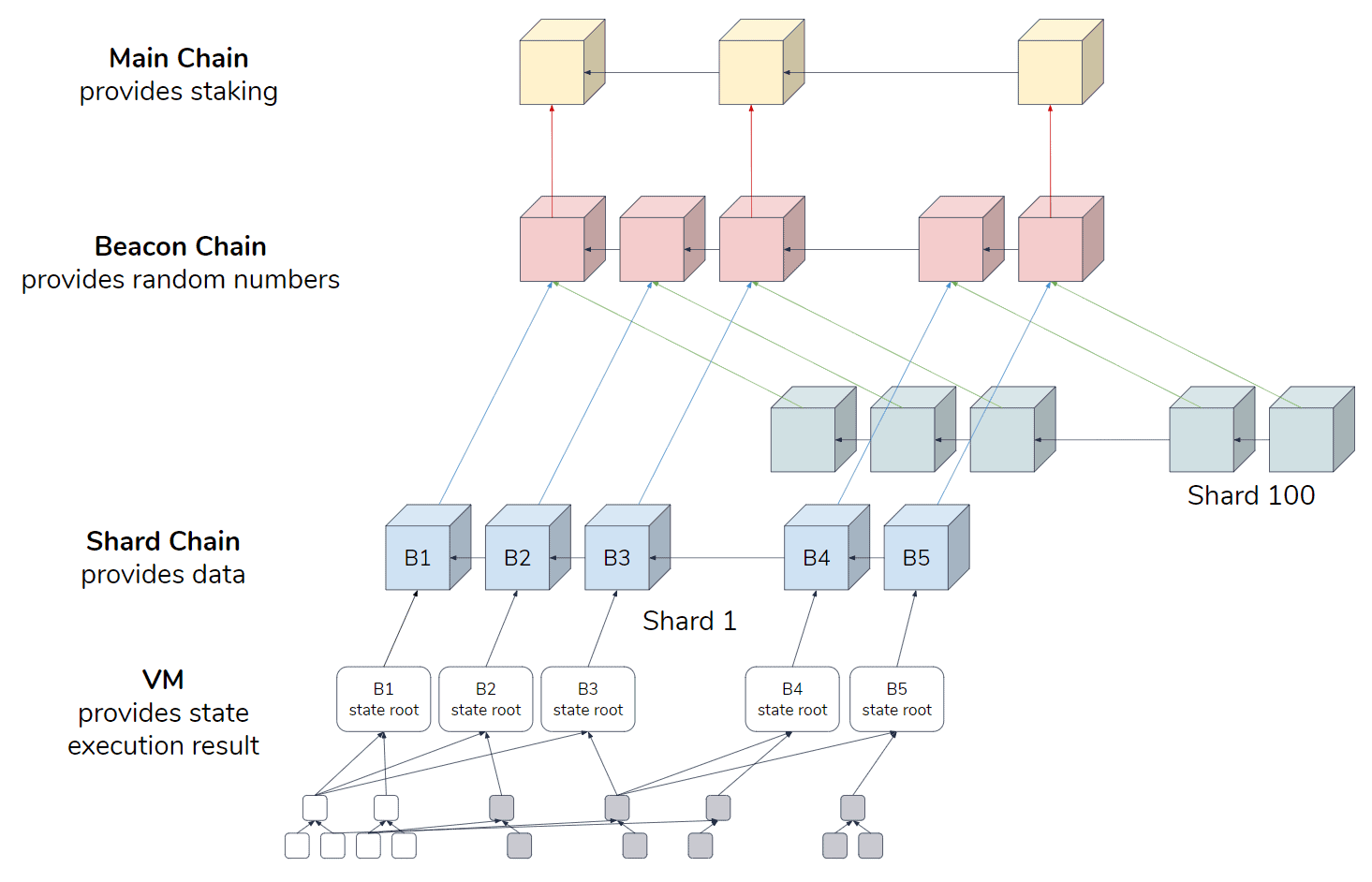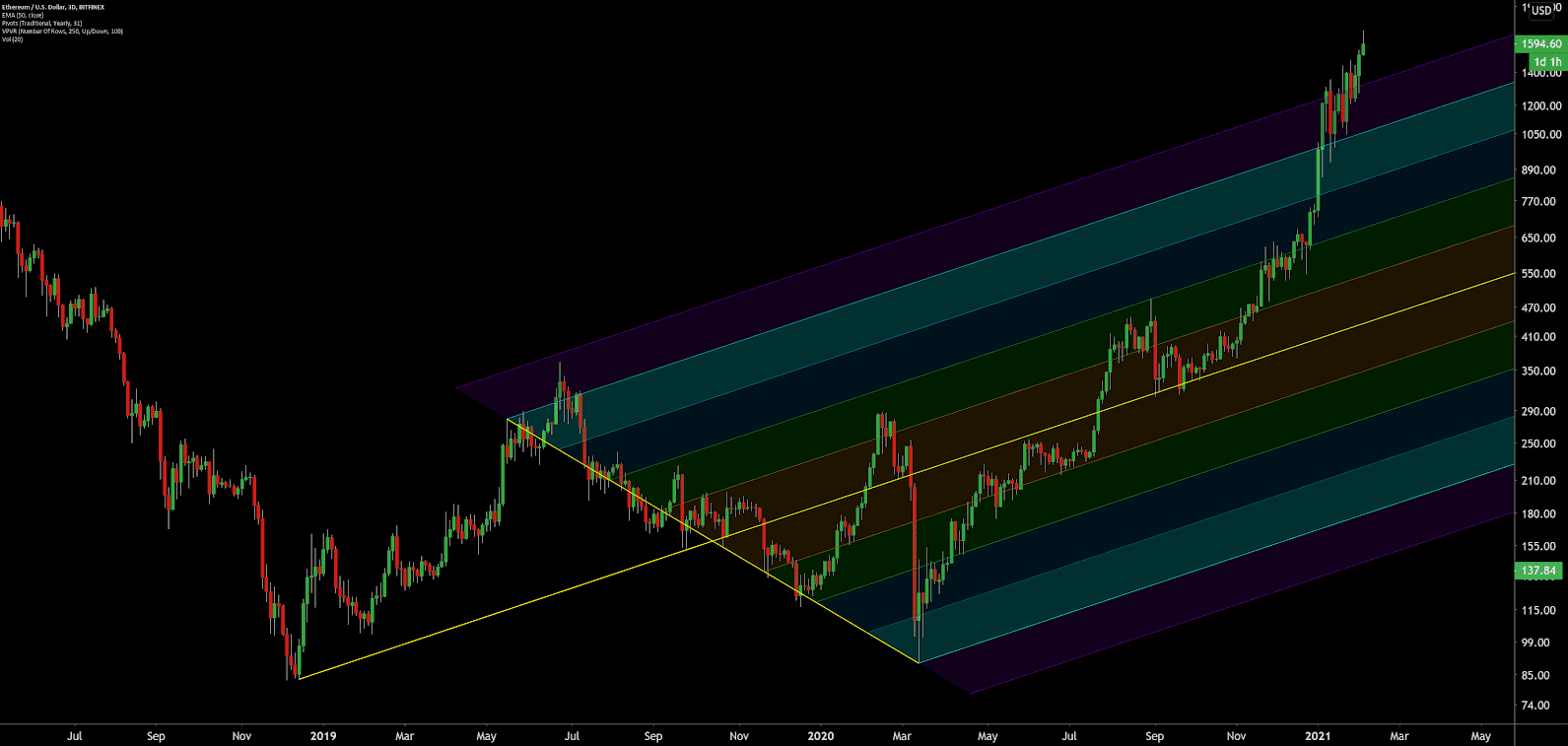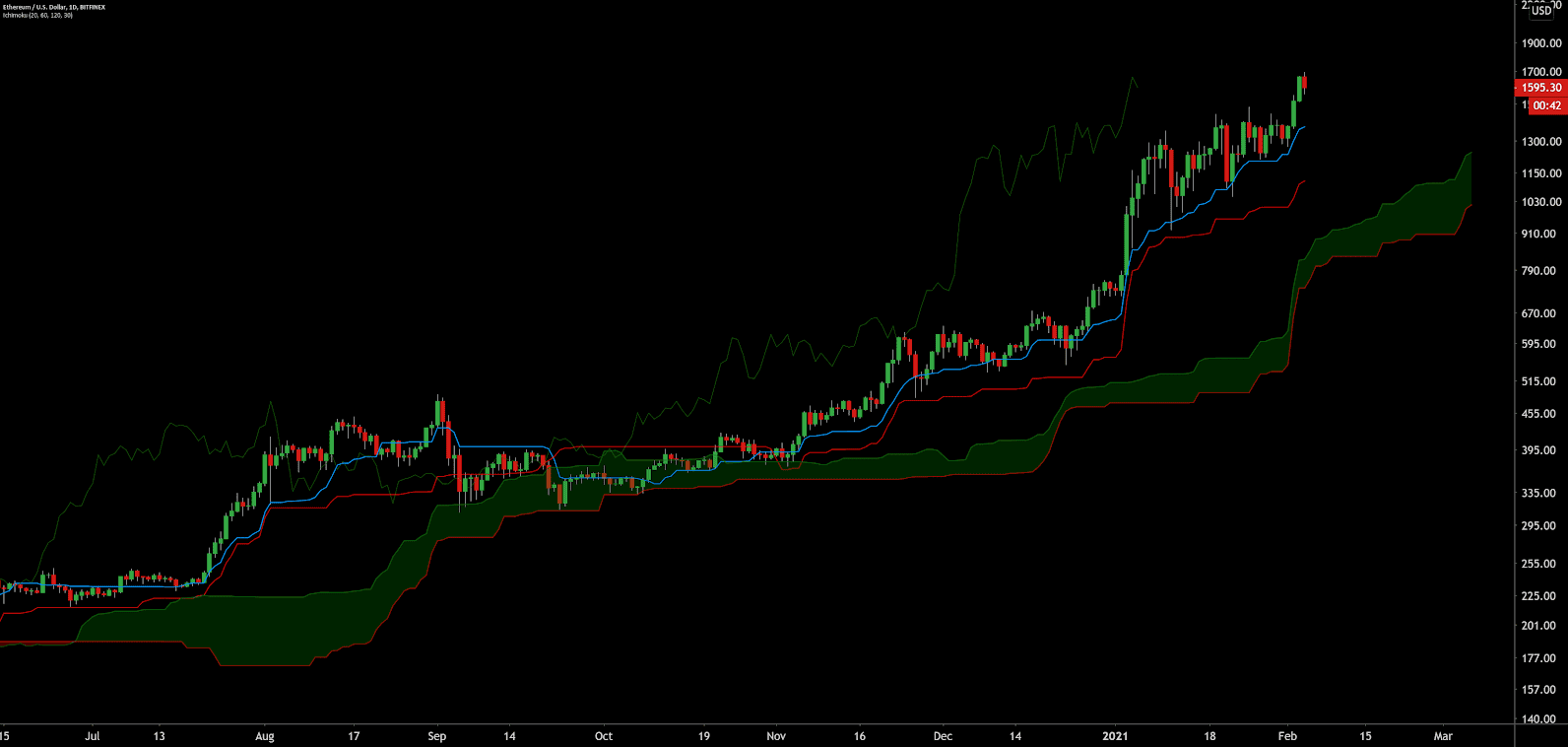Ethereum Price Analysis – All-time highs for on-chain activity and price
On-chain fundamentals including hash rate, difficulty, transactions per day, daily active addresses, and transaction fees all sit at or near all-time highs.
Ethereum (ETH) is a distributed ledger and decentralized computing platform with smart contract capabilities. The crypto asset is currently second on the BraveNewCoin market cap table, with a market cap of US$184 billion and US$13.25 billion in trade volume over the past 24 hours.
The ETH project was proposed by Vitalik Buterin in 2013. Other co-founders include Anthony Di Iorio, Charles Hoskinson, Mihai Alisie, Amir Chetrit, Joseph Lubin, Gavin Wood, and Jeffrey Wilcke. An Initial Coin Offering (ICO) followed in 2014. The ICO raised nearly US$16 million, with each token selling for US$0.31. The ETH ICO would eventually become one of the most profitable in history.
The network mainnet went live in July 2015 with 72 million pre-mined coins, which currently accounts for 63% of the circulating supply. On Christmas day 2019, Wilcke sent 92,000 ETH, US$11.5 million, to the Kraken exchange, presumably to sell. ETH was launched with no vesting schedule or lock-in period for the pre-mined coins.
Thus far, protocol upgrade milestones have included; Olympic in May 2015, Frontier in July 2015, Homestead in March 2016, Metropolis Part 1: Byzantium in October 2017, Metropolis Part 2: Constantinople in February 2019, Istanbul in December 2019, and Muir Glacier in January 2020.
Ethereum is upgraded through a series of Ethereum Improvement Protocols (EIPs), which are then bundled into each hard fork. The Github repository for EIPs has been extremely active since January 2019.
Source: Github – EIPs
In total, almost 1,000 developers have contributed nearly 30,000 commits to the ETH project in the past year, across 247 Github repos. Most of the commits over the past year have occurred in the Solidity repo, the programming language used to write smart contracts on Ethereum.
Source: Github – solidity
An adjacent protocol overhaul, Serenity, is currently in development and includes a full
rewrite and redesign, which will result in Ethereum 2.0. Phase zero of the herculean task began in November 2020, with 2.9 million ETH currently being staked. Both versions of ETH will exist concurrently for some time before a migration is completed. Danny Ryan, Justin Drake, and Vitalik Buterin have the most commits in the ETH 2.0 repo.
Overall, ETH related repos have had more commits than any other crypto project over the past year. In December 2019, Buterin released an alternative proposal for merging ETH 1.0 to ETH 2.0 on an accelerated schedule and less re-architecturing. Buterin also explained in 2020 that the “initial deployment of ethereum’s layer 2 scaling strategy has basically succeeded” and needs further refinement and deployment.
Source: GitHub – eth2.0-specs
Source: CryptoQuant
ETH 2.0 includes Sharding and Casper, which will drastically alter the network. Sharding refers to a scaling solution for horizontally partitioning data within a database. The full implementation of Casper, slated for release in 2022, will remove Proof of Work (PoW) from the network and replace it with Proof of Stake (PoS), with a block reward at 0.22 ETH/block. Currently, there are no plans to cap the total amount of ETH created.
Source: Hsiao-Wei Wang
While the network is still PoW based, Programmatic PoW (EIP 1057) was also being discussed as a poison pill to reduce ASIC mining on a network by increasing the efficiency of GPU and FPGA mining. ProgPoW is only likely to be implemented if future hash rate increases are driven by ASICs. Bitmain, Innosilicon, and PandaMiner all have at least three ASIC miners available for the EtHash algorithm, while a new ASIC mining chip from a fourth mining company, Linzhi, was released in October 2019.
If implemented, EIP 1057 will make all current Ethash ASICs unable to mine the chain. Those using Ethash ASICs may choose to continue mining the pre-fork chain. Another possibility is that ASICs will be used to mine the Ethereum Classic (ETC) chain, which also uses the Ethash algorithm. In any case, the goal of decreasing ASIC use on the ETH chain will be successful, although likely temporary.
At US$0.04/KWh, all of the currently available Ethash ASICs are profitable. Much of the network is mined on the newest GPUs, many of which have been out of stock for months. Mining profitability has increased dramatically since March, recently reaching a two-year high. However, if ETH prices or fees fall dramatically, the hash rate will likely decline.
Source: asicminervalue
Hash rate (solid line, chart below) has steadily increased from January 2020 lows and now sits at a new all-time high. Difficulty (dashed line, chart below) had risen steadily since April 2019, becoming disconnected from the hash rate in October 2019. This rise in difficulty despite a fall in hash rate is coded into Ethereum and known as an Ice Age, or difficulty bomb, which has activated twice before on Ethereum, once in 2017 and once in late 2018.
The most recent Ice Age was meant to serve as a transition from ETH 1.0 to ETH 2.0 and phase out PoW mining completely. However, because ETH 2.0 was not ready for deployment, the Ice Age has been pushed back another four million blocks, to block 13.2 million, via a hard fork on January 2nd.
Source: BitInfoCharts
Average block times are currently 13.07 seconds with blocks per day (line, chart below) currently near an all-time high. There are approximately 113.4 million ETH in circulation with inflation per annum currently at 4.30% (fill, chart below), which sits near an all-time low. Despite record fast block times, pending transactions have been ranging above 150,000 over the past few weeks, with only a few smart contracts accounting for most of the transactions.
Source: CoinMetrics
Tether (USDT) was originally issued on the OMNI chain in 2015, but has been aggressively swapped to an ERC-20 token over the past two years. In total, nearly 67% of all circulating USDT is now on the ETH chain. ERC-20 transfers are both cheaper and faster than OMNI transfers, thus many exchanges have added the option for ERC-20 USDT in recent months.
ERC-20 USDT transactions per day and average transaction values have quickly surpassed OMNI transactions per day and average transaction values. ERC-20 USDT transactions per day are now 44x OMNI USDT transactions per day. ERC-20 transfers also account for 16% of all daily transactions on ETH currently.
Source: CoinMetrics
According to etherscan, the Ethereum network currently has 8,500 active network nodes, 33% of which are located in the United States and nearly 58% of these nodes are running through Cloud hosting services. Due to the somewhat cumbersome hardware and time requirements of running a node, many of these nodes are run by Infura, or similar node servicers, who provide access to the network for developers. These services have become increasingly important as the blockchain continues to grow. In mid-November, Infura reported an outage that drastically reduced transactions on the ETH blockchain.
Nodes have several sync modes, with fast sync requiring approximately 640 GB of storage and a full archival node requiring over 6.29 TB of storage. A full node stores a snapshot of the entire network in every contract at every point in time. In contrast, a Bitcoin full node requires just over 370 GB of storage.
Source: Etherscan
The average number of on-chain transactions per week (line, chart below) is currently 1.26 million, a new all-time high. This remains up from a multi-year low of 430,000 in February 2019. Transactions per day have remained above one 1.0 million since July 2020
Average weekly transaction fees (fill, chart below) are now US$12.40, a new all-time. In June 2020, fees were heavily skewed thanks to two transactions that sent $2.6 million each in fees, likely related to a gas extortion attempt or white-hat hack of a Ponzi scheme. However, fees on ETH had been rising significantly over the past two months even before these two transactions were sent and have continued to rise since early June.
In September 2019 and June 2020, miners voted to increase gas limits by 25% (bottom chart, below), which has alleviated some fee pressure. Gas limits are once again near-maximum capacity, increasing the possibility of further increases in the Gas ceiling.
Source: CoinMetrics
Source: Etherscan
The 30-day network value to estimated on-chain daily transactions (NVT) ratio (line, chart below) is currently 44 and slowly falling. A clear uptrend in NVT suggests a coin is overvalued based on its economic activity and utility, which should be seen as a bearish price indicator, whereas a downtrend in NVT suggests the opposite. An NVT holding below 30 would likely signify bullish market conditions, as was the case from April 2017 to May 2018. NVT does not factor in most DeFi-related transactions.
Monthly active addresses (MAAs) are currently nearing 580,000 (fill, chart below). MAAs are up from a yearly low of 192,000 in February, but slightly down from an all-time high of nearly 610,000 in January 2018. Overall, MAAs remain well above levels seen throughout 2017 and earlier. Unique addresses continue to grow at a rapid rate and are just over 136 million (not shown). However, addresses can only be added to the network, and are never deleted.
Source: CoinMetrics
The top Ethereum based dapps over the past month, ranked by volume, are led by DeFi and exchange dapps. These ETH dapps also dominate volume metrics when compared to other chains, including Tron and EOS. Uniswap also has the most reported users over the past month at 330,000.
Overall, ETH has a considerably lower number of users and transactions compared to other dapp platforms like EOS (EOS) and Tronix (TRX), both of which have no transaction fees. In February 2019, Twitter user Kevin Rooke pointed out that of the 1,375 ETH dapps, 86% had zero users and zero transaction volume. There are currently over 2,000 dapps listed on dappradar, 90% of which have zero reported users or transaction volume in the past month.
Source: DappRadar
The Decentralized Finance movement, or DeFi, has increasingly gained in popularity with the total ETH held in DeFi currently nearing 7.0 million ETH or US$9.31 billion. Lending and borrowing dapps, DEXs, and so-called “yield-farming” dapps, have seen the biggest influx of money as their products began to provide a return for users. The stablecoin ecosystem MakerDAO currently holds around 18% of all ETH in the DeFi ecosystem.
Source: DefiPulse
Worldwide Google Trends data for the term "Ethereum" spiked in July 2019 and February 2020, which matched a swift increase in price. Over the past few weeks, searches hit a new all-time high. Worldwide Google Trends data for the terms “Defi Crypto” have also hit a new all-time high over the past week while “Yield Farming” searches have decreased from highs in recent weeks.
A slow rise in searches for "Ethereum" preceded both highs in June 2017 and January 2018, likely signaling interest from new market participants at that time. A 2015 study found a strong correlation between the Google Trends data and BTC price, while a May 2017 study concluded that when the U.S. Google "Bitcoin" searches increased dramatically, BTC price dropped.
Source: Google Trends – “Ethereum”
Source: Google Trends – “Defi Crypto”
Source: Google Trends – “Yield Farming”
Technical Analysis
Roadmaps for future market movements can be found on high timeframes using Exponential Moving Averages, Volume Profile Visible Range, Pitchforks, Ichimoku Cloud, and divergences. Further background information on the technical analysis discussed below can be found here.
On the daily chart for the ETH/USD pair, the 50-day Exponential Moving Average (EMA) and 200-day EMA Golden Cross on February 11th was quickly followed by a bearish Death Cross on March 19th. On May 6th, 2020, these key EMAs re-crossed bullish, suggesting the 200-day EMA at US$676 will now act as support. Price is now over 2x from the 200-day EMA.
Based on the Volume Profile Visible Range (VPVR – horizontal bars, chart below), the current spot price now sits above all significant volume nodes. Yearly Pivots, or mathematical support and resistance based on the highs and lows of the previous year, also sit at US$530, US$970, and US$1,200, and US$1,625. Additionally, a growing bearish divergence on volume and RSI is present to suggest waning bullish momentum.
The long/short open interest on Bitfinex (top panel, chart below) is currently 65% long with long positions decreasing significantly over the past few weeks. Bitfinex long/short ratios have historically had little bearing on Ethereum price action.
Price has been contained within a bullish Pitchfork (PF) since mid-2019. Once the trend is defined, the spot price will continually attempt to return to the median line (yellow), currently at US$435. A bullish PF is invalidated once the spot price falls below the lowest support, currently at US$180. The uppermost diagonal currently sits at US$1,300.
Turning to the Ichimoku Cloud, four metrics are used to indicate if a trend exists; the current price in relation to the Cloud, the color of the Cloud (red for bearish, green for bullish), the Tenkan (T) and Kijun (K) cross, and the Lagging Span. The best entry always occurs when most of the signals flip from bearish to bullish, or vice versa.
Daily Cloud metrics with doubled settings (20/60/120/30), for more accurate signals, are bullish; the spot price is above the Cloud, the Cloud is bullish, the TK cross is bullish, and the Lagging Span above the Cloud and above the current spot price. The trend will remain bullish so long as the spot price remains above the Cloud. Kijun support currently sits at US$1,116.
Lastly, on the two-day ETH/BTC chart, trend indicators are bullish with price above both the 200-period EMA and daily Cloud. Strong VPVR support sits in the 0.031 BTC zone with yearly pivot support at 0.038 BTC. Further upside will likely find resistance at the VPVR, yearly pivot, and psychological level of 0.05 BTC. ETH/BTC open interest on Bitfinex is 99.9% long (not shown). Additionally, a growing bearish divergence on volume and RSI is present to suggest waning bullish momentum.
Conclusion
On-chain fundamentals including hash rate, difficulty, transactions per day, daily active addresses, and transaction fees all sit at or near all-time highs. The ProgPoW consensus algorithm change is not likely coming this year, a change that would drastically alter the current Ethash mining landscape. Although ETH 2.0 is still in the early stages of development and release, the new protocol is actively being discussed, debated, and coded, with a phase zero release slated for as early as November this year. Over 2.9 million ETH currently sits in the 2.0 staking contract.
The quantity of ETH locked in DeFi apps has increased significantly over the past year as ETH held by ICO treasuries continued to decrease, potentially providing a new avenue to decrease the circulating ETH supply. As DeFi usage increases, on-chain metrics need to be retooled to better represent and include smart contract activity, such yield farming and stablecoin transfers. NVT, an inverse metric of economic utility, is currently decreasing only slightly, despite significant DeFi activity.
Technicals are bullish for both the ETH/USD and ETH/BTC pairs based on current trend metrics, as the spot price is currently above both the 200-day EMA and the daily Cloud. Upside targets sit at US$2,000 and 0.05 BTC with support at US$1,200 and 0.031 BTC. Both pairs also show early signs of bearish divergence on volume and RSI, suggestive of waning bullish momentum in the near term.

Don’t miss out – Find out more today


























